The following article was written for the Orchid Species Bulletin published by the Orchid Species Society, which is based in Brisbane, Queensland in March 2004, and updated in November 2023.
Bear in mind that any cultivation notes refer to the subtropical conditions of Southern Queensland, Australia.
Vanda suavis was described by John Lindley in the Gardeners’ Chronicle and Agricultural Gazette in 1848. The specific epithet comes from the Latin suavis (sweet, pleasant, delightful), referring to the sweetly perfumed flowers that are fragrant during the day. James Veitch reduced V. suavis to a variety of V. tricolor in Manual of Orchidaceous Plants in 1887-94, because William Hooker believed that there was no structural difference to separate them specifically. Martin Motes (2001), however says that it “is sufficiently distinct to warrant species status in any other genus.” Motes (2021) recognises V. suavis as distinct from V. tricolor.
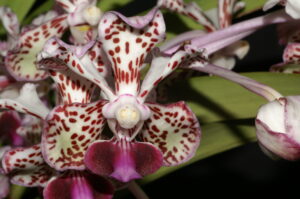
V. suavis is a large, erect, lithophytic, epiphytic or terrestrial plant, which produces stout stems that are 50-100 cm or more long. The woody stems bear 20 or more curved, strap-shaped leaves in two ranks. The leaves are placed about 2 cm apart, and are v-shaped in cross-section, and measure 30-45 cm long and 3-4 cm broad. Upright to spreading or arched inflorescences that are 17-27 cm or more long, are produced from the upper leaf axils. Strong mature plants usually produce 2-4 racemes at a time. Each raceme carries 7-15 or more, large showy flowers. Variable in colour, the blooms are 5-7.5 cm across and 5-8 cm long when measured vertically. The sweetly fragrant flowers open together, and last for about 3-4 weeks.
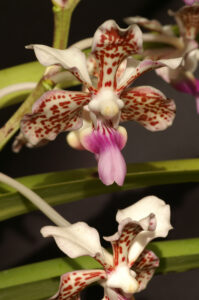
The sepals and petals of V. suavis are white to pale yellow, and variably spotted with bold, vivid red-purple to red-brown spots and bars on the inner surface. The sepals and particularly the petals are often characteristically reflexed, but the flowers are usually flat on the first day they open. The two-toned purple lip is deep purple in the basal half of the disc and the apical portion of the midlobe is paler. The lip of V. suavis is described as being 3-lobed and is up to 2.5 cm long and 1.8 cm broad. The side lobes are squarish or oblong and incurved, while the convex midlobe is somewhat fiddle-shaped (pinched in the middle) and deeply notched at the tip. There are 3 ridges on the lip, two of which extend to the apical margin.
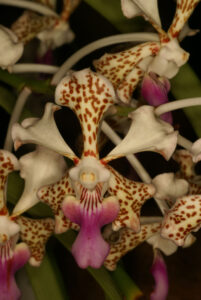
Jim Comber (1982) says that V. suavis is found in East Java and Bali. He adds that specimens from different parts scarcely vary in sepal and petal colour although the side-lobes of the lip can be deep or pale pink and the midlobe can be pink or white. Compared with V. tricolor from West Java, V. suavis has more flowers per inflorescence, longer pedicels and the flowers are somewhat larger. Comber also cites another distinguishing feature of V. suavis being that the lip is not in one plane like V. tricolor. The lip is narrower and pinched in the centre and has the margins more reflexed or deflexed. Lucien Linden (1885-1888) pointed out that the inflorescences of V. suavis are completely arched over, while those of V. tricolor are upright.
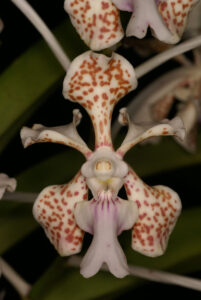
Jim Comber says that V. suavis thrives in the high branches of trees remaining in semi-open situations, and is never found in dense, dark forests. Its habitat varies in altitude from 700-1,700 m elevation. Because of the variation in altitude of its habitat, V. suavis seems to tolerate a wide temperature range in cultivation. It grows and flowers better in temperate climates rather than in tropical lowlands.
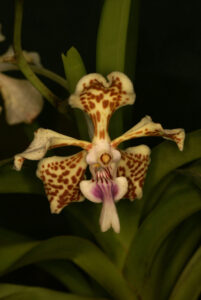
In the southeast Queensland region V. suavis requires bright light such as 50-70% shade, and a coarse or well-drained medium. The thick white roots dislike being confined in a pot, so this species is better suited to cultivation in a basket. Water it often, and maintain high humidity, with good air circulation during the warmer months. For winter, I recommend a minimum of 12 C, with a drier rest, while the root tips are not green. Occasional misting or watering in the morning of sunny days during the cooler months, will prevent the plant from dehydrating and leaf drop.
References:
Bechtel, H., Cribb, P. & E. Launert. (1992). The Manual of Cultivated Orchid Species. 3rd ed. London: Blandford Press.
Comber, J.B. (1982) “The Genus Vanda in Java.” The Orchid Digest, 46 (4): 124-129.
Comber, J.B. (1990) Orchids of Java. Bentham-Moxon Trust, Royal Botanic Gardens, Kew.
Cox, J. M. (1946). A Cultural Table of Orchidaceous Plants. Sydney: The Shepherd Press.
Grove, D.L. (1995). Vandas and Ascocendas and Their Combinations with Other Genera. Timber Press, Portland, Oregon.
Linden, J. (1860). Pescatorea – Iconography of Orchids. 1994 English edition. Turriers, France: Naturalia Publications.
Linden, J., Linden, L., Rodigas, E. & R.A. Rolfe. (1885-1888). Lindenia – Vol. 1. 1993 reprint. Turriers, France: Naturalia Publications.
Linden, J., Linden, L., Rodigas, E. & R.A. Rolfe. (1894-1898). Lindenia – Vol. 4. 1993 reprint. Turriers, France: Naturalia Publications.
Motes, M.R. (1997) Vandas – Their Botany, History and Culture. Timber Press, Portland, Oregon.
Motes, M. (2001) “Hybridizing with Lesser-Known Vandas – Part V. The influence of Vanda tricolor var. suavis.” Orchids, 70 (10): 934-943.
Motes, M. (2021) The Natural Genus Vanda. Redland Press, Redland, Florida.
Sanders, C.F., F.K. & L.L. (1927). Sanders’ Orchid Guide. St. Albans: Sanders.
Sprunger, S. ed. (1991). Orchids from the Botanical Register 1815-1847. Basel, Germany: Birkhäuser Verlag.
Stearn, W.T. (1983) Botanical Latin. 3rd ed. David & Charles Inc. Vermont, USA.
